A crash course on particle physics (for the steemSTEM meetup at CERN) - 3 - All about the Higgs
Here is the third episode of my particle physics crash course that will be given at CERN, on February 9th, prior to the moment where 20 Steemians will enter the LHC to visit the CMS detector. With this series of posts, I intend to browse all the glory details underlying the world of the elementary particles.
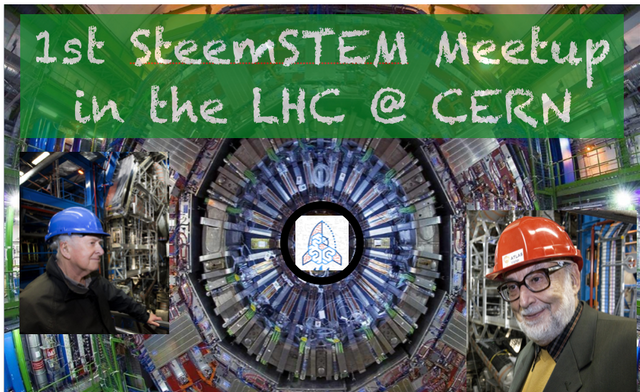
After focusing on the structure of matter (here) and on the form of the interactions between the fundamental particles (there), it is now time to discuss what the two guys on the above picture have done to get the Nobel prize in 2013.
THE SUCCESS OF GAUGE SYMMETRIES
In the previous episode, I have described what gauge symmetries are and how the interactions between the fundamental particles are modeled as gauge boson exchanges. In the Standard Model, we have a bunch of these bosons, also known as force carriers mediating the fundamental forces of nature.
One or more than one of them is associated with each of the fundamental interactions. Those are the photon (related to electromagnetism), the W-boson and the Z-boson (related to the weak interaction) and the gluons (related to the strong interaction). I recall that gravity is ignored.
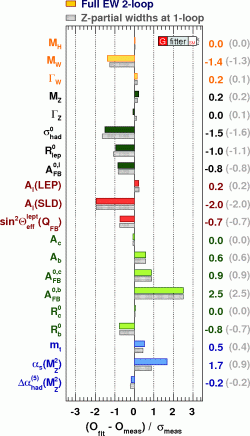
[image credits: the GFitter collaboration]
But why are those gauge symmetries important? Well, because the underlying predictions have been tested in several thousands of different measurements during more than 50 years.
There is up to now (almost) not a single sign of any deviation! This is the reason why the Standard Model is accepted so far as the model describing the world of the fundamental particles.
The level of agreement is illustrated on the picture on the left.
One can observe the differences, expressed in standard deviations, between theory and data for about 15 measurements. I recall that we need 3 sigmas for a hint for a new phenomenon, and 5 sigmas to claim for a discovery. Everything is thus fine.
We can thus explain most data with gauge symmetries. Almost. There is indeed a drawback. The gauge symmetries enforce all particles to be massless, which is not verified in nature. But on the other hand, it cannot be too wrong, as it works so well…
SUPERCONDUCTIVITY TO SAVE THE SHIP
In the 1960s, Philip Anderson, one of the world expert on superconductivity, realized an important point. He was studying superconductivity and observed that when a theory exhibits both some gauge symmetries and a spontaneous breaking of the gauge symmetry, the massless gauge bosons were actually getting massive.
The underlying mechanism is by no way different from the well known Brout-Englert-Higgs mechanism of particles physics, except for special relativity that is not necessary for superconductivity. Well-known? Well maybe not outside particle physics. But this does not matter for the rest of this post, where the important features will be sketched (tagging @sco here) :)
The relativistic example was provided 2 years later, in this publication written by François Englert and Robert Brout and this one by Peter Higgs, which is probably why Anderson is less known in the field.
But what is spontaneous symmetry breaking?
It can be explained with a pencil, as shown on the figure on the right.
On the left panel of the figure, the pencil holds vertically, assuming that it is somehow held. As soon as one lets it go, it goes and falls (the right panel).
But in which direction can it fall? Any is the answer. The pencil can fall anywhere in the gray circle.
This means that the ensemble of all solutions has a revolution symmetry around the pencil axis (the pencil axis on the left panel of course). However, as soon as the pencil falls, the symmetry is lost. One says that it is spontaneously broken. It is exactly the same thing for the case of gauge symmetries.
THE RISE OF THE HIGGS BOSON
In the Standard Model, one only needs one ingredient to implement the spontaneous breaking of the electroweak gauge symmetry: a scalar field (i.e. the Higgs field). The self-interactions of this scalar field are known as the scalar potential. And as for any potential, it has to be minimized to understand how nature works.
There is an infinity of solutions minimizing the potential an the ensemble of solutions possesses a symmetry (like our pencil before falling). Nature picks one (our pencil falls), and the symmetry is broken.
As a consequence, the W and Z bosons get massive, but there is a remnant of the symmetry breaking mechanism, an extra particle called the Higgs boson. On top of that, the Higgs field can also be used to make all fermions massive! This is a kind of 2 for 1 sale, as we all know that matter is massive!
Why is this working? Why is this the mechanism chosen in nature? Well, again, data tells us.
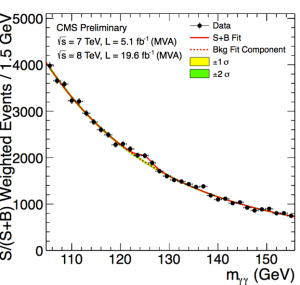
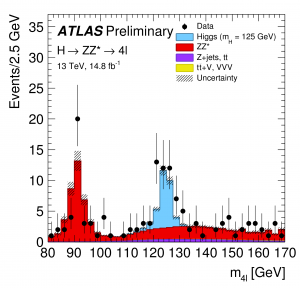
[image credits: the CMS and ATLAS collaborations]
The figure on the left is one of the CMS results that have led to the discovery of the Higgs boson. CMS investigated LHC collisions in which two photons are produced. The dashed line is the no-Higgs prediction, whilst the red line (the fit of the data points) consists in what is observed. There is a little bump in there, compatible with a Higgs boson.
The error bars are so small that there is less than one chance on almost 2 millions that this is not a signal.
On the right figure, it is a more recent figure, from ATLAS, where physicists have scrutinized a four-lepton final state. The Higgs boson is predicted to contribute via a decay into intermediate Z bosons). The red is here the background, and the blue the Higgs signal. Data is clear enough, once again :)
Today, the situation is even better: the properties of the Higgs boson are fully compatible with the expectation of the Standard Model, as shown by CMS and ATLAS.
There is however one caveat. the LHC is not the right machine to precisely measure the form of the Higgs potential… It can barely constrain it, and a future machine is thus necessary for getting the final words of this story.
SUMMARY
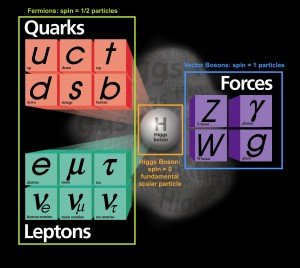
[image credits: Fermilab]
In this post, I finalized my introduction to the Standard Model of particle physics.
All the particles shown on the left have been introduced. The matter component (left part) was detailed here, the interactions were discussed there and in this present post, I discussed the Higgs boson.
In my future posts, I will detail how we managed to discover the Higgs. This requires two ingredients: theory and data. I will thus describe how to make predictions out of the Standard Model, and how to observe a Higgs signal in CMS (as this is the detector we will visit during the meetup).
The associated slides are available at the same address as before. More information can also be found in particular in this textbook (which I would use for introducing particle physics to bachelor students). This is also a great blog article on the Higgs mechanism.
SteemSTEM
SteemSTEM is a community-driven project that now runs on Steemit for more than a year. We seek to build a community of science lovers on Steemit and to promote well written/informative Science Technology Engineering and Mathematics (STEM) postings in order to make Steemit a place for fascinating STEM content.
More information can be found on the @steemstem blog and on the Steemit chat and in our last project report.

Thank you @Lemouth for this excellent mini-series. It really makes me regret not being able to join the visit :-(.
Actually, it reminds me of a video about the LHC published a few years ago, and that I found really funny and at the same time educational.
It presents how the LHC investigates the mysteries of nature, and all this on a groovy funky beat. As a musician and lover of physics, I found this clip really cool ;-).
PS: at the time of release, the Higgs had not been found yet...
Ah yeah I remember this one. It became kind of viral in the community at that time ^^
You mention the Higgs Potential... I remember reading somewhere that the field was actually in a metastable state, i.e. that its potential was not at its strict minimum.
So should we expect that at any second, this potential could collapse further? What event could act as activation energy (is the potential of the Higgs field actually modifiable by an event)?

(apologies for the very approximate representation - I think sometimes too much as a solid state chemist ;-))
I am not really worried actually, because if this happened, we wouldn't even realize what is going on: the spreading of this new phase of space would be at the speed of light. It would definitely change how the universe looks like (imagine a different set of values for the mass of particles... what a mess that would cause! ).
What do you think about that?
Is it possible that locally the Higgs field could fall to another state of less energy, hence spreading out at the speed of light, and transforming the universe and its physics' constants? Could an event trigger this? If yes, what type of event?
Maybe. There are error bars, and the calculations have been done in the Standard Model only. If we have new particles somewhere, then the results do not hold.
Now let's go back to the rest of your comment. The results of the Standard Model stability calculation can be found here. The 1-2-3 sigma areas are obtained from the measurement of the Higgs boson and top quark masses. It indeed points towards metastability. But having no new phenomena between the Standard Model and the Planck scale is a super strong assumption.
Let us assume this is the case, then we can calculate the time necessary for tunneling from one vacuum to the next one. We are save, as I have written here.
[Funnily enough, your comments make me resurrecting old articles I wrote here. I like that/ Ylu also make me often thinking. I like it too ;) ]
Wow, super interessant cet article!
So a 40% variation of a parameter of the Higgs self interaction leads to a prediction for the life of the universe from inferior to atosecons to 10241 years! lol!
Well, at least, we know it has been around for about a 1010 years... so the chances it collapses during the few million years of humanity's lifetime are small enough to not be worried...
These calculations involves a tunelling process.
Actually my question has a more classical touch to it: no tunelling, but just an event which could act as activation from one minima to the other.. Do you think that such an event would be possible?
Or would it require so much energy localised in a small region of space, that a black hole would form immediately. Black holes would be saving our universe by confining a zone with a different Higgs field potential.
Funny idea don't you think? :-)
I don't think this would be possible, but this goes slightly borderline with respect to my expertise (so that I may be wrong).
...all about that Higgs, 'bout that Higgs, no treble...
Oh Jesus, how many billions will that cost?!
Not so many, if you integrated the fact that the cost is shared, that it is spread over many years, that plenty of people are formed and could thus get a better salary when getting back to the private sector, that operating costs is paid to the society, etc... You may be interested in reading this good old article I wrote long ago.
No worries, I was only joking, I'm very much in favor of spending for science! The internet was the greatest invention of the last century, and its value is immeasurable, and it came mostly from you guys. No one can predict the value of scientific discoveries, which is why arguing in the usual way of 'cost vs benefit' makes no sense. The value of building a football stadium can be more or less determined because it at least has limits, whereas the value of building something for science cannot be framed because it's potentially infinite for all practical purposes, like discovering an incredibly cheap source of energy or something.
EDIT: I'm reading the article you linked to, and you state almost the same thing:
Sorry for answering only now. Your answer was hidden in the flow ;)
But yes, we fully agree. It is a pity politics often don't agree too :(
I'm beginning to feel like a student of particle physics :).
Like I once said earlier, and I'm reiterating it here again: "I can confidently sit for an exam in particle physics and pass, drawing knowledge from the things I've read from your blog" :)
Great work sir
Do you want to try? :D
Lol. Maybe for the elementary part of it; yes sir :D
Well,. I am actually not sure I will design one just for you.... But maybe one day, who knows :D
I'd be honoured sir :)
Have started looking at Part 1 and Part 2. Particle physics is something I know very little about, so I appreciate the time you put into this. Thanks :)
You are welcome! I hope people will learn stuff in reading (I tried to be as simple as possible, although sometimes it is tough).
great post, but I have to confess you lost me halfway... Me and physics ;-)
At which point exactly. I know this one is a bit more technical than the previous one... Please let me know and I will extend the discussion.
aaaaah! well known? dammit^^
I read it again from that point and I think I more or less get the Higgs boson now. But that sentence really freaked me out ;-)
Actually, you only need to know the name.... The rest is (not explained) below :p I will rephrase this. Thanks ^^
Don't worry about your difficulty in understanding, even Einstein had his problems :)
Here, it is more a problem in my explaining :D
Some things are just hard to explain, maybe that is why I'm a terrible teacher. Lol
By the end of this crash course, everyone reading/following this blog would become a quantum physicist of sorts :)
Rather a particle physicist. I guess I will have to open PhD positions for steemians soon :D
That is correct. I wouldn't mind being the first enroled student. Coincidentally, I did come across gauge symmetry breaking yesterday when checking on the Bose-Einstein Condensate.
Coincidences are sometimes nice ;)
another PhD? Nooooooooooooooooooooooooooooooooooooo....(sound is lost in eternal space)
lol
Great post!
Thanks!
Thank you for posting. extraordinary
You are welcome!
Amazing post, just followed and resteemed, Follow me back and upvote my posts as well. Hope we can be good friends.